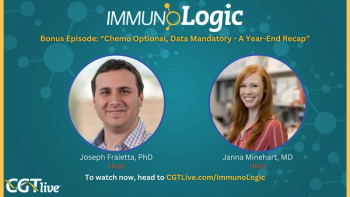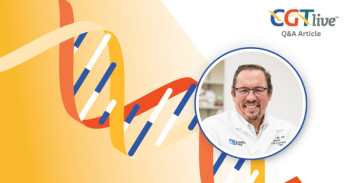
Gene Therapy for Chronic Pain To Be Explored Under NINDS Grant
Benjamin Harrison, BSc, PhD, assistant professor of biochemistry and nutrition at UNE, shared his thoughts on the research.
A University of New England (UNE) researcher will investigate the potential for treating chronic pain through gene vector therapy with support from a $1.8 million grant awarded from the
Benjamin Harrison, BSc, PhD, assistant professor of biochemistry and nutrition at UNE, and his colleagues have previously discovered that pain-transmitting nociceptors contain a protein called CELF4, which will be a focal point of the new research. CELF4 is an RNA-binding protein that they suspect inhibits the production of cellular components, such as ion-channels and receptors, that are involved in pain sensing. The primary goal of the research will be to determine whether an adeno-associated virus (AAV)-based gene therapy administered to pain neurons can stimulate production of CELF4 and yield subsequent pain reduction.
“There are some chronic pain conditions that are simply intolerable, and people with those conditions are willing to do severe surgeries to reduce their pain,” Harrison said in a statement.1 “Using this novel gene therapy vector approach, we can develop pain therapies that are less invasive than surgery and carry fewer risks than conventional opioid medications.”
Harrison’s research will not be the first to investigate gene therapy as a potential treatment for chronic pain. A 2021 mouse study by Moreno et al utilized
In an interview with CGTLive, Harrison offered his perspective on his team’s previous research and their plans for the future.
Can you elaborate on your previous discovery of CELF4 in nociceptors that provided the basis for this research? What key info should the clinical community take away from what is currently known?
Benjamin Harrison, BSc, PhD: We found CELF4 during a search for a “master control switch” for persistent pain. There are a whole bunch of proteins made by pain-sensing neurons (nociceptors) so they can monitor the health of our bodies. For example, nociceptors respond to inflammation, injuries, etc. by synthesizing new cellular components/machinery. This is by a process called activity-dependent, de novo protein synthesis. These new protein components are things like ion channels and signaling molecules, that have the effect of “sensitizing” the pain neurons, causing us to guard that tissue from further harm.
Unfortunately, this natural process can go wrong, leading to chronic/maladaptive pain. I suppose you could say that some pain is good, if it reminds us to be careful. Unfortunately though chronic pain is definitely not good, it interferes with many people’s daily lives and is huge problem for society as a whole.
We wanted to develop a way to interrupt activity-dependent de novo protein synthesis in nociceptors, thereby reducing/preventing nociceptor sensitization.
I’m a molecular biologist by trade. This training made me theorize that a molecular master control switch should exist, that functions to regulate nociceptor sensitization and persistent pain. If it existed, this switch would limit activity-dependent de novo protein synthesis in nociceptors, thereby limiting the synthesis of the new proteins responsible for persistent pain. So, we designed a search for this theoretical master control switch, using computational biology. Essentially, advances arising from the human genome project allowed us to examine the sequences of genes that sensitize nociceptors. We downloaded the sequences of “pain sensitizing genes” from the National Library of Medicine website. We then lined them up together on the same page, and carefully looked for patterns/similarities.
On these gene sequences, we found a sequence motif for a “docking site” for an RNA-binding protein called CELF4. Our theory is that CELF4 docks with (physically binds to) pro-nociceptive genes to limit their translation into protein.
We tested this hypothesis using genetically modified animals: CELF4 knock-out animals were strikingly sensitive to innocuous stimuli like mild heat and light touch, thus demonstrating that CELF4 is a negative regulator of thermal and mechanical sensitivity (to date unpublished work). We have therefore generated a mouse that is more sensitive to pain. And while this is an exciting scientific advance, it does not meet our goal of generating a model mouse that is less sensitive to pain. We needed to apply for a grant to do this. We were successfully awarded a new grant that will allow us to determine if gene delivery of CELF4, using a gene therapy vector, will cause a state of reduced pain sensitivity.
What do you see as the unmet treatment needs for patients with chronic pain? What makes gene therapy more promising for meeting these treatment needs compared to other methods?
There are many people that suffer with ongoing extreme pain that cannot be treated by conventional approaches. These people are at suicide risk, living their lives in pain. We want to ultimately help these people by offering them an opportunity to reduce the activity of their pain sensing neurons by gene therapy. This would be preferable to surgical approaches that work by causing permanent loss of sensation, e.g., by removing sensory ganglia. Also, pain can often return even after surgery because pain neurons in neighboring tissues sprout over and become sensitized. Gene therapy may allow permanent relief.
What future directions do you see this research going in?
Next, we need to put together a team of clinicians, pharmacologists, clinical trials experts, and other domain specialists to move this “basic research” into the clinic. Our dream is to provide relief to people with severe intractable pain, so they can enjoy their lives without suffering.
Transcript edited for clarity.
REFERENCES
1. UNE researcher awarded $1.8 million to study chronic pain relief through gene therapy. New release. University of New England. June 21, 2022. https://www.une.edu/news/2022/une-researcher-awarded-18-million-study-chronic-pain-relief-through-gene-therapy
2. Moreno AM, Alemán F, Catroli GF, et al. Long-lasting analgesia via targeted in situ repression of NaV1.7 in mice. Sci Transl Med. 2021;13(584):eaay9056. doi:10.1126/scitranslmed.aay9056
Newsletter
Stay at the forefront of cutting-edge science with CGT—your direct line to expert insights, breakthrough data, and real-time coverage of the latest advancements in cell and gene therapy.





































